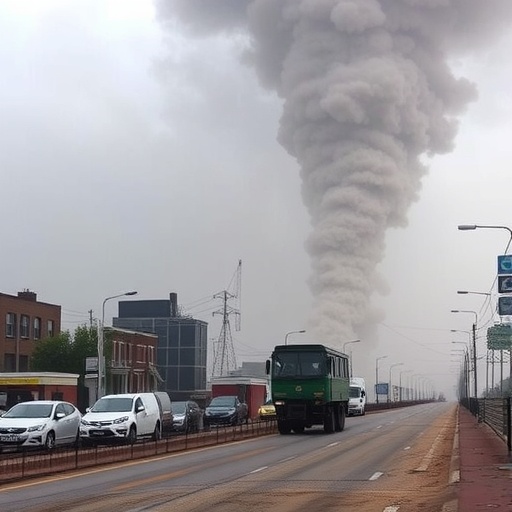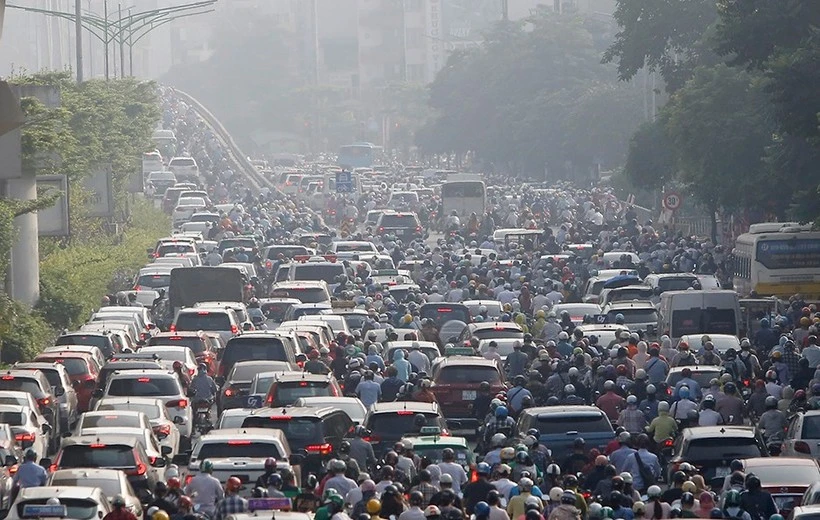Urban Dust: Health Risks of Micro Rubber and Vanadium – Bioengineer.org

Report on Urban Street Dust Contamination and its Implications for Sustainable Development Goals
1.0 Introduction
A study conducted in Northwest Iran provides critical data on the composition and spatial distribution of urban street dust, with a specific focus on micro rubber and vanadium particles. This report analyzes the study’s findings, highlighting their direct relevance to several United Nations Sustainable Development Goals (SDGs). The research underscores the urgent need for integrated policy responses to mitigate the public health and environmental risks associated with urban pollution, directly impacting the achievement of SDG 3 (Good Health and Well-being) and SDG 11 (Sustainable Cities and Communities).
2.0 Summary of Research Findings
The investigation employed advanced spatial and chemical analysis to assess the prevalence of micro rubber and vanadium in urban street dust. The primary findings are categorized below.
2.1 Pollutant Distribution and Sources
- Spatial Hotspots: High concentrations of micro rubber and vanadium were identified in areas with high traffic density, establishing a direct correlation between vehicular activity and pollution levels.
- Source Attribution: The pollutants originate from anthropogenic activities central to urban life.
- Micro Rubber: A direct byproduct of tire wear and degradation.
- Vanadium: Primarily from industrial emissions and the combustion of fossil fuels.
2.2 Public Health Implications
- Health Risks: Exposure to these particulates through inhalation and dermal contact is linked to significant health issues, including respiratory and cardiovascular diseases.
- Vulnerable Populations: Children and the elderly are identified as being at heightened risk, a critical consideration for public health equity and achieving SDG 3.
2.3 Environmental and Ecological Impacts
- Ecosystem Contamination: Runoff from contaminated street dust pollutes adjacent soil and water systems, introducing toxic materials into natural habitats.
- Biodiversity Threat: This contamination disrupts local ecosystems and food chains, posing a threat to biodiversity and undermining progress towards SDG 14 (Life Below Water) and SDG 15 (Life on Land).
- Climate Change Link: The study notes that changing climate patterns may exacerbate the mobilization of dust particles, compounding pollution challenges and impacting urban resilience, a key component of SDG 13 (Climate Action).
3.0 Alignment with Sustainable Development Goals (SDGs)
The study’s findings have profound implications for the 2030 Agenda for Sustainable Development. The challenges posed by micro rubber and vanadium pollution are directly linked to the following goals:
- SDG 3: Good Health and Well-being: The documented health risks from urban dust directly challenge Target 3.9, which aims to substantially reduce deaths and illnesses from hazardous chemicals and air, water, and soil pollution.
- SDG 11: Sustainable Cities and Communities: The research highlights a failure in urban management that contravenes Target 11.6, which calls for reducing the adverse per capita environmental impact of cities, particularly concerning air quality.
- SDG 12: Responsible Consumption and Production: The sources of the pollutants—tire wear and fossil fuel combustion—point to unsustainable patterns of production and consumption that must be addressed to meet targets related to the environmentally sound management of chemicals and waste.
- SDGs 14 & 15: Life Below Water and on Land: The environmental degradation caused by contaminated runoff directly impedes efforts to protect aquatic and terrestrial ecosystems from land-based pollution sources.
4.0 Recommendations for Policy and Action
To address the issues identified and advance the SDGs, a multi-faceted approach is required, integrating scientific findings into public policy and community action.
4.1 Urban Planning and Governance
- Implement traffic management strategies to reduce congestion in residential areas.
- Integrate green infrastructure, such as vegetation along roadways, to capture dust and pollutants.
- Enhance municipal services to include regular and effective street cleaning to control dust accumulation.
4.2 Public Health and Awareness
- Launch public education campaigns to inform citizens about the health risks of urban dust and sources of pollution.
- Develop targeted public health initiatives to protect vulnerable populations.
- Promote community-led monitoring and advocacy for cleaner urban environments, fostering partnerships as envisioned in SDG 17.
4.3 Environmental Management
- Establish policies to control industrial emissions and promote cleaner transportation technologies.
- Invest in research and technology to mitigate tire wear pollution and manage urban runoff effectively.
5.0 Conclusion
The research on micro rubber and vanadium in urban street dust serves as a critical call to action. It demonstrates that overlooked pollutants have significant consequences for public health, environmental integrity, and the successful achievement of the Sustainable Development Goals. An integrated strategy that combines robust scientific research, informed public policy, and active community engagement is essential for creating sustainable, healthy, and resilient cities for all.
Analysis of Sustainable Development Goals in the Article
1. Which SDGs are addressed or connected to the issues highlighted in the article?
-
SDG 3: Good Health and Well-being
- The article extensively discusses the significant threat urban pollution, specifically micro rubber and vanadium in street dust, poses to public health. It highlights links to respiratory diseases and cardiovascular conditions, emphasizing the risks for vulnerable populations like children and the elderly.
-
SDG 11: Sustainable Cities and Communities
- The core issue is urban pollution resulting from city life, particularly high traffic volumes. The article calls for better urban planning, traffic management, and dust control measures like street cleaning and vegetation to make cities safer and more sustainable.
-
SDG 13: Climate Action
- The text explicitly mentions that the effects of climate change, such as rising temperatures and shifting weather patterns, can worsen urban dust pollution by increasing the mobilization of dust particles. It advocates for integrating climate resilience strategies into urban planning.
-
SDG 15: Life on Land
- The article points out the environmental dimension of the problem, where contaminated dust runs off into nearby soil and water bodies. This introduction of toxic materials can harm biodiversity, disrupt food chains, and affect terrestrial ecosystems.
2. What specific targets under those SDGs can be identified based on the article’s content?
-
Target 3.9: By 2030, substantially reduce the number of deaths and illnesses from hazardous chemicals and air, water and soil pollution and contamination.
- The article directly aligns with this target by investigating the health implications of harmful particles (micro rubber and vanadium) in urban dust. It calls for preventative measures to combat the adverse health effects, such as respiratory and cardiovascular diseases, caused by this form of pollution.
-
Target 11.6: By 2030, reduce the adverse per capita environmental impact of cities, including by paying special attention to air quality and municipal and other waste management.
- The research focuses on a key aspect of urban environmental impact: pollution from street dust linked to traffic. The call for dust control measures, better urban planning around traffic patterns, and regular street cleaning are direct strategies to improve urban air quality and reduce the city’s negative environmental footprint.
-
Target 13.2: Integrate climate change measures into national policies, strategies and planning.
- The article supports this target by recommending a proactive approach from city planners to integrate climate resilience strategies into urban planning. This is proposed to mitigate the compounded impacts of dust pollution, which may be exacerbated by climate change.
-
Target 15.1: By 2020, ensure the conservation, restoration and sustainable use of terrestrial and inland freshwater ecosystems and their services.
- The article connects to this target by highlighting how contaminated urban dust can run off into surrounding soil and water, negatively impacting local ecosystems, biodiversity, and food chains. Addressing urban dust is therefore linked to protecting terrestrial habitats from pollution.
3. Are there any indicators mentioned or implied in the article that can be used to measure progress towards the identified targets?
-
Indicator for Target 3.9 & 11.6: Concentrations of micro rubber and vanadium in urban street dust.
- The study’s entire methodology is based on measuring the spatial distribution and concentration of these specific pollutants. The article states that researchers “employed sophisticated spatial analysis techniques to identify hotspots of high micro rubber and vanadium concentrations.” Tracking these concentration levels over time would be a direct indicator of progress in reducing urban pollution and its associated health risks.
-
Implied Indicator for Target 3.9: Incidence of pollution-related health issues.
- While not explicitly measured in the study, the article implies that a key indicator of success would be a reduction in the “myriad of health issues, including respiratory diseases and cardiovascular conditions” linked to particulate matter exposure. Monitoring the incidence of these conditions in vulnerable populations within polluted urban areas would serve as a public health indicator.
-
Implied Indicator for Target 11.6 & 13.2: Implementation of dust control and climate resilience policies.
- The article advocates for public policies that incorporate “dust control measures” and “climate resilience strategies into urban planning.” An indicator of progress would be the number and effectiveness of such policies being adopted and implemented by city governments, such as regular street cleaning schedules, the creation of green barriers along roads, and updated urban planning codes.
-
Implied Indicator for Target 15.1: Levels of contaminants in surrounding ecosystems.
- The article mentions the “run-off of contaminated dust into nearby soil and water bodies.” An implied indicator for measuring progress would be the periodic testing of soil and water in ecosystems adjacent to urban areas to monitor the levels of micro rubber and vanadium, thereby assessing the impact on biodiversity and ecosystem health.
4. Table of SDGs, Targets, and Indicators
| SDGs | Targets | Indicators |
|---|---|---|
| SDG 3: Good Health and Well-being | Target 3.9: Substantially reduce deaths and illnesses from hazardous chemicals and air, water and soil pollution. |
|
| SDG 11: Sustainable Cities and Communities | Target 11.6: Reduce the adverse per capita environmental impact of cities, paying special attention to air quality. |
|
| SDG 13: Climate Action | Target 13.2: Integrate climate change measures into national policies, strategies and planning. |
|
| SDG 15: Life on Land | Target 15.1: Ensure the conservation, restoration and sustainable use of terrestrial and inland freshwater ecosystems. |
|
Source: bioengineer.org
What is Your Reaction?
 Like
0
Like
0
 Dislike
0
Dislike
0
 Love
0
Love
0
 Funny
0
Funny
0
 Angry
0
Angry
0
 Sad
0
Sad
0
 Wow
0
Wow
0
















































:focal(1500,1000)/https://media.globalcitizen.org/a6/9a/a69a4720-d8a1-4715-b596-18738d03c05c/rotary_polio_hero_image.jpg?#)







/countries/sri-lanka/photo-credit---dmc-sri-lanka.tmb-1200v.jpg?sfvrsn=dc298bcc_1#)

















